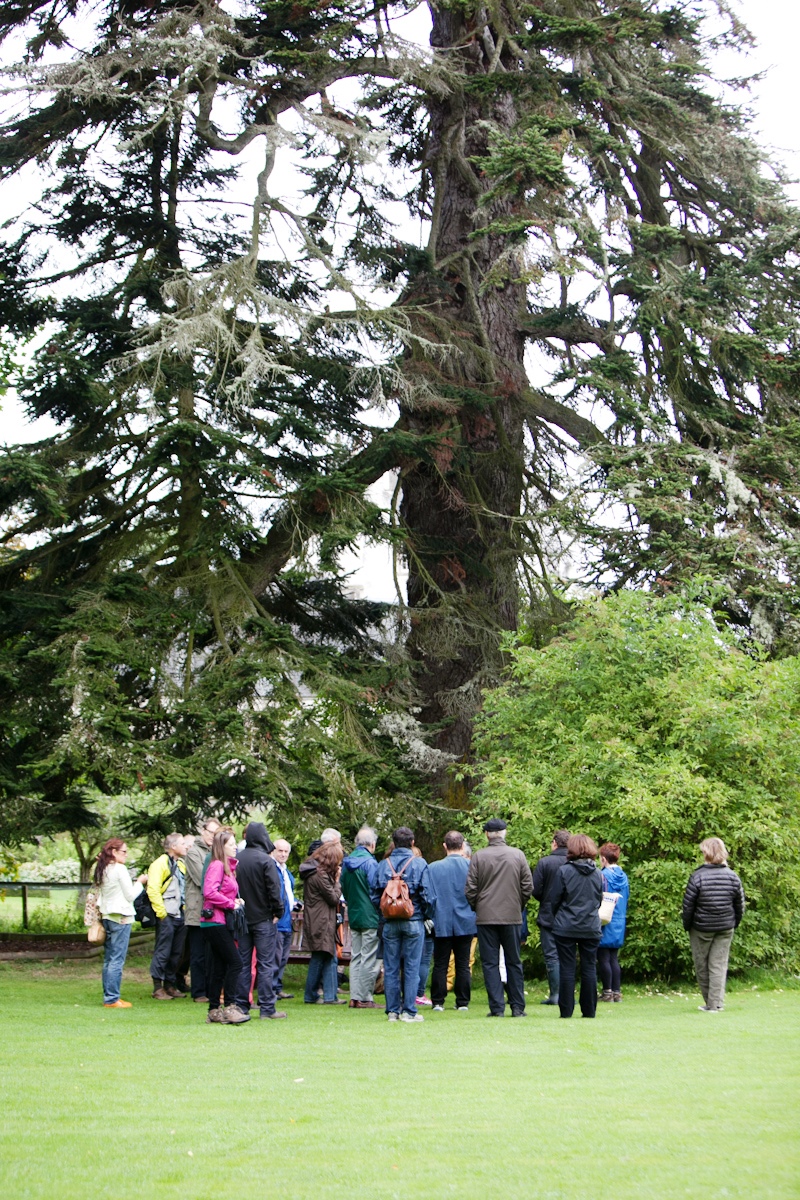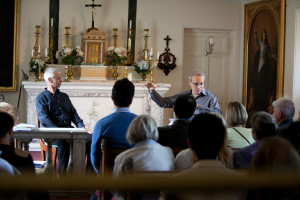
The 4th Grāmatas, Robežas un velosipēdi festivāls notika Skotijas visilgāk pastāvīgi apdzīvo mājokli, Traquair Māja upes Tweed Skotijas Borders. Organizē Beyond Borders Skotijā tas ir unikāls festivāls literatūras un domas, kas apvieno vadošos rakstnieki, politiķi, karavīri, juristi un mākslinieki, lai apspriestu ar starptautiskajām attiecībām aktuālas tēmas Skotijas lomu pasaulē. Divas sarunas “Izpratne par islāma pasauli” un “Irāka pēc desmit gadiem: Kas Nodarbības Sīriju un U.N.?"Sedz apliecinājums platumu diskusijas. SNSI koordinators, Robert Wild piedalījās divos pasākumos; pastaiga ar nosaukumu "Ja koki varētu runāt – Ko viņi saka?", un runāt par "Senās un Sacred Dabas Sites Neuroscience".

Grupa uz liecības ar Ian Edwards, vadītājs notikumiem pie Royal Botanic Garden Edinburgh, diskutējot par kultūras asociāciju koku vienlaikus Catherine Maxwell, kura ģimene ir bijusi uzturēšanās 300 gadiem ar nosacījumu, ka vēsturi koku. (Fotogrāfijas pieklājīgi Beyond Borders)
Svētdienas rītā gājienā bija "Runājot Zinātne Project"Sadarbībā ar Royal Botanic Garden Edinburgh. Tā izpētīt Traquair vēsturisko ainavu un atklāja stāstus par savu apbrīnojamo koku (www.traquair.co.uk). Īans Edvardss, vadītājs notikumiem pie Royal Botanic Garden Edinburgh, lika runāt par bio-ģeogrāfiskos vēstures un kultūras asociācija koku no īpašuma, tostarp īve, Kaļķi, Sudraba egle un lazda. Katrīna Maksvela Stjuarte, īpašnieks un kura ģimene ir bijusi uzturēšanās 300 gadiem ar nosacījumu, ka vēsturi koku.
Grupa gatavo ar diskusiju ietvaros kontemplatīvs vietas, ko rada Ancient Īves, kas varētu būt izdzīvojuši no brīža, nu jau noskaidroti Ettrick mežu, kurā Traquair House - medību no Skotijas karaļi, jo apkārt 1107 – sākotnēji atradās. Roberts apgalvoja, ka, ja koki varētu runāt, viņiem varētu būt daži jautājumi, piemēram, mums: Ko jūs darīt, lai Ettrick Forest? Kas uz zemes jūs esat darījuši, lai puse no mežiem uz planētas? Vai jūs varat iedomāties, jums izskatīties pēc mums koki? Mēs patiešām rūpējamies par jums!
Pēc pastaigas saruna notika pārpildītajā kapelā. Nosaukums "Seno un svēto dabas vietu neirozinātne: Wsenās vietas izraisa tik spēcīgu ietekmi pār mūsu kultūru, un tās ir jāaizsargā konfliktu laikā., sarunā tika pētītas svētās dabas vietas un tika izveidotas saites uz jauno izpratni par neirozinātni.
Roberts iesāka, sakot, ka svētās dabas vietas var raksturot kā vietas, kur cilvēka prāts satiekas ar dabu. Viņš novēroja, ka Traquair kapela (, kas ir salīdzinoši jauns pielāgots šim nolūkam 1829) bija dažas norādes raksturs, bet ka tas ir ļoti iespējams, ka visi mūsu svētās telpas sākotnēji iegūti no dabas.
Roberts devās, lai aprakstītu svētās dabas teritoriju bija un kāpēc viņi ir ieguvuši interesi par starptautisko saglabāšanas kustības. Dabas aizsardzības praktiķiem ir ļoti pragmatiska interese par svētajām dabas vietām, jo tās aizsargā plašu retu sugu klāstu.. Tas ir īpaši svarīgi, jo mēs tagad esam iegājuši 7th liels izmiršana notikums, simtiem sugu katru dienu izzūd. Tālāk par šo, tomēr, svētās dabas vietas arī iegult dziļu kopumu arhetipi par cilvēciskajām attiecībām, lai mēs varētu mācīties no, nosakot ilgtspējīgāku ceļu cilvēcei.
Viens šāds jēdziens ir tas, ka "Rezervāts" šķiet, ka tas ir tiešs imports no senajām Eiropas svētbirzēm agrīnajā kristiešu baznīcā. Svētnīca radās Eiropas svētbirzīs, kur, medības nebija atļautas un, ja nomedītais dzīvnieks atrada patvērumu svētbirzī, medības bija jāpārtrauc. Svētajā birzī patvērumu varēja atrast arī cilvēku bēgļi. Daudzi no šiem krājumiem joprojām ir saglabājušies Āfrikas un Āzijas svētbirzīs. Kādā brīdī šis svētnīcas princips tika pārnests uz baznīcu.

Pirms nokļūst uz svēto uz neiroloģijas, Robert Wild (kreisi) pētīja svētās vietas kā potenciālās jomas konfliktu ierobežošanai. (Fotogrāfijas pieklājīgi Beyond Borders)
Beidzot, un pirms nokļūst uz svēto uz neiroloģijas, Robs koncentrējās uz svētajām vietām kā iespējamām konfliktu ierobežošanas zonām. Robs iepazīstināja ar piemēru, ar kuru nesen dalījās kolēģi no Aigines kultūras pētījumu centrs attiecībā uz 2010 Kirgizstānas konflikts, kur simtiem cilvēku tika nogalināti un tūkstošiem cilvēku ir pārvietoti konflikts starp kirgīzu un uzbeku uz dienvidiem no valsts. Daudzi no pārvietoto iedzīvotāju atraduši patvērumu svētā vietā, lai būtu drošs patvērums laikā konfliktu:
"Kamchieva Mopasha etniskajā Uzbekistānas romānus un 'shaiyks"Vai aizbildnis vietas valstīm: “Ja ir katastrofa, cilvēki nāk uz šo svētnīcu, un rast patvērumu ". Pēc viņas teiktā, augstumā konflikta jūnijs 2010, [daudzi cilvēki] gāja tur gan kirgīzu un uzbeki, bet tie nav jautā, kas ir kas, [bet] kopā piedāvāja upuri Dievam, lūdzot, lai atjaunotu mieru un harmoniju. Daudzi svētceļnieki bija palicis uz šiem diviem vai trīs dienas [Konflikta] pie malas Mazar (svētvieta). Kā [viens intervētais] Akbarov Salbar said, "Nav viens deguna vai viena mute bija ievainots". Vēl viens intervētais teica, ka svētās vietas ir jomas nevardarbības, un turklāt vietas, kur tiek veikti pasākumi, lai pārvarētu vardarbību”.
Šajā brīdī Roberts pēc tam nodeva Timam Filipsam. Tims ir starptautisks miera uzturētājs un līdzdibinātājs Hārvarda universitātes projekts par Tieslietu Times Transition un ir bijis iesaistīts daudzos miera sarunās, tostarp Ziemeļīrijā, Šrilanka un Tuvajos Austrumos.
Tims iepazīstināja ar jauno neirozinātnes disciplīnu un apsprieda nesen gūtās mācības saistībā ar konfliktu risināšanu. Tas ietver to, ka dažādās smadzeņu daļās tiek apstrādāti dažāda veida domāšanas modeļi. Dažādas smadzeņu daļas apstrādā dažādas emocijas un domas, kas ir līdzīgas evolūcijas posmiem. Tagad tiek saprasts, ka racionālā doma tiek apstrādāta citā smadzeņu daļā, kurā ir dziļi un svētas vērtības. Šīs jaunās izpratnes būtiski ietekmē veidu, kā mēs risinām sarunas par jautājumiem. Tas ir gadījums, kad šķietami racionālus risinājumus dziļi glabātām vai svētām vērtībām sarunu komandas nevarēs viegli apsvērt.
Svētās dabas vietas ir bijušas strīdīgas zemes, tajā pašā laikā miera un sadarbības vietas. Tajos ir iekļauti arī kritiski cilvēku attiecību modeļi ar dabu. Laikā, kad mūsu attiecībām ar dabu nepieciešama būtiska dziedināšana; garīgais, zinātniskā un sociālā izpratne par cilvēku uzvedību un rīcību, ir svarīgi.






